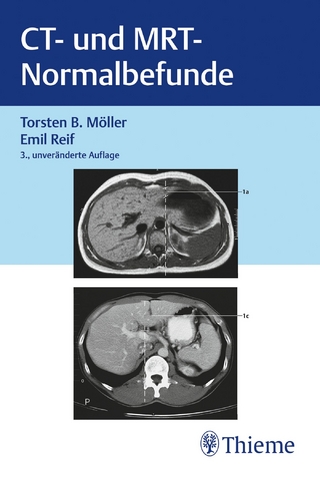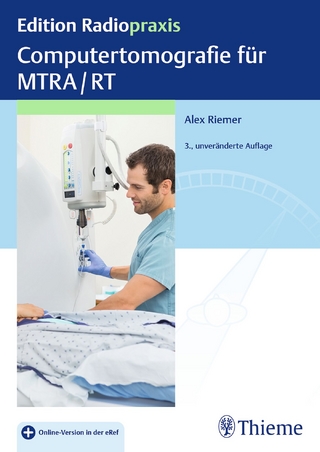
Clinical Breast Tomosynthesis
Thieme Medical Publishers (Verlag)
978-1-62623-208-2 (ISBN)
Although it is increasingly being implemented in imaging centers, hands-on clinical learning tools have been lacking - until now. Written by renowned breast imaging specialists, this multimedia textbook is the most definitive DBT reference available. The first section is dedicated to DBT fundamentals, including physics, reconstruction methods, acquisition parameters, and patient dose and data size considerations. The next two sections are case-based clinical practice presentations, organized by DBT screening and diagnostic components.
Key Features:
- The use of 3D breast imaging to detect and differentiate malignancies from normal and benign findings
- 100 case studies include pertinent clinical information, introductory images, and findings labeled on subsequent images with BI-RADS terminology
- Full field digital mammography and/or synthetic 2D mammogram images included in all case studies mirror what is typically encountered in DBT breast-imaging programs
- Clinical pearls on navigating the technology, interpreting images, making diagnoses, and decisions regarding follow-up studies
- Accompanying online videos further elucidate the still images
This remarkable, interactive reference is a must-have for trainee and practicing radiologists and will also benefit mammography technicians. The detailed case studies and videos demonstrate the full utility of DBT as a screening and diagnostic technology in context with mammography, ultrasound, and MRI of the breast.
Part I: Introduction to Clinical Breast Tomosynthesis
1 The Physics of Digital Breast Tomosynthesis
2 BI-RADS Nomenclature for Mammography and Ultrasound
Part II: Cases with Screening Tomosynthesis Evaluation Needing No Further Evaluation
3 Fat-Containing Mass on Baseline Mammogram
4 Radiolucent Lesions with Calcifications
5 Architectural Distortion
6 Architectural Distortion on a Full-Field Digital Mammogram
7 No Skin Edge
8 Grouped Calcifications
9 Scattered Masses
10 Treated Breast Cancer
11 "Hairy" Skin Edge
12 Linear Calcifications
13 Multiple Masses
14 Nonpalpable Mass with Mixed Composition
15 Calcifications
16 Architectural Distortion
17 Oval Mass in High-Risk Patient
18 Resolved Clinical Finding
19 Breast Reduction Years Ago
20 Axillary "Calcifications"
21 Nonpalpable Mass
22 Increased Breast Density
23 Possible Architectural Distortion
24 Architectural Distortion
Part III: Cases with Screening Tomosynthesis Evaluation Needing Further Diagnostic Evaluation
25 Mass with Architectural Distortion
26 Developing Asymmetry
27 High-Density Mass
28 Mass on Baseline Mammogram
29 Amorphous Calcifications
30 Obscured Mass within Dense Breast Tissue
31 Mass Only Seen on One View
32 Mass on Baseline Mammogram
33 Architectural Distortion
34 Grouped Amorphous Calcifications
35 Architectural Distortion Only Seen on Tomosynthesis
36 Small Spiculated Mass
37 Mass on High-Risk Screening Mammogram
38 Architectural Distortion Best Seen on Digital Breast Tomosynthesis
39 Focal asymmetry
40 Obscured Mass
41 Subtle Mass
42 Coarse Heterogeneous Calcifications
43 Amorphous Calcifications
44 Developing Asymmetry
45 Focal Asymmetry with Architectural Distortion
46 Circumscribed Mass on Baseline Mammogram
47 Two Areas of Architectural Distortion
48 Architectural Distortion within Dense Breast Tissue
49 Calcifications and Possible Focal Asymmetry
50 Developing Asymmetry
51 Obscured Mass and Architectural Distortion Findings
52 Mass After Reduction Mammoplasty
53 Architectural Distortion
54 Obscured Mass
55 Architectural Distortion
56 Linear Calcifications
57 Developing Asymmetry
58 Enlarging Mass
59 Developing Asymmetry in a Patient with Treated Breast Cancer
Part IV: Cases with Screening and Diagnostic Tomosynthesis Evaluations
60 Circumscribed Mass
61 Developing Asymmetry
Part V: Cases with Diagnostic Tomosynthesis Evaluation Recalled from Conventional Screening Mammogram
62 Possible Focal Asymmetry
63 Architectural Distortion within Dense Breast Tissue
64 Architectural Distortion with Negative Ultrasound
65 Focal Asymmetry with Architectural Distortion
66 Focal Asymmetry-One or Two Lesions
67 Asymmetry on the Craniocaudal View
68 Asymmetry on the Craniocaudal View
69 Small Adjacent Masses
70 Oval Mass at 6 O'Clock
71 Architectural Distortion with Calcifications
72 Focal Asymmetry
73 Architectural Distortion
74 Calcifications with Architectural Distortion
75 Asymmetry on the Craniocaudal View
76 Linear Asymmetry
77 Architectural Distortion
Part VI: Cases with Diagnostic Tomosynthesis Evaluation Presenting with Clinical Indication
78 Right Axillary Palpable Finding and Left Breast Pain
79 Palpable Masses with No Mammographic Correlate
80 Palpable Breast Masses
81 Asymmetric Breast Tissue or Mass
82 New Palpable Finding at Site of a Remote Benign Image-Guided Biopsy
83 Palpable Breast Mass
84 Palpable Mass on First Mammogram
85 Palpable Thickening
86 Right Breast Pain
87 Breast Pain
88 Palpable Axillary Mass
89 Spiculated Retroareolar Mass with Linear Calcifications
Part VII: Cases with Known Cancer Diagnosis Needing Additional Evaluation
90 Oval Mass Seen on Digital Breast Tomosynthesis
91 Retroareolar Extension
92 Regional Calcifications
93 Fine-Linear Branching Calcifications
94 Regional Calcifications
95 Cancer Occult to Imaging
Part VIII: Intervention: Biopsy Using Tomosynthesis or Stereotactic Guidance
96 Introduction to Localization and Biopsy Using Tomosynthesis
97 Developing Asymmetry
98 Spiculated Mass Not Seen on Ultrasound
99 Mass with Indistinct Margins
100 Heterogeneous Calcifications
101 Palpable Spiculated Masses
102 Architectural Distortion
103 Architectural Distortion
| Erscheinungsdatum | 15.08.2017 |
|---|---|
| Zusatzinfo | 750 Abbildungen |
| Verlagsort | New York |
| Sprache | englisch |
| Gewicht | 2 g |
| Einbandart | gebunden |
| Themenwelt | Medizin / Pharmazie ► Medizinische Fachgebiete ► Gynäkologie / Geburtshilfe |
| Medizin / Pharmazie ► Medizinische Fachgebiete ► Onkologie | |
| Medizinische Fachgebiete ► Radiologie / Bildgebende Verfahren ► Computertomographie | |
| Medizinische Fachgebiete ► Radiologie / Bildgebende Verfahren ► Nuklearmedizin | |
| Medizinische Fachgebiete ► Radiologie / Bildgebende Verfahren ► Radiologie | |
| ISBN-10 | 1-62623-208-3 / 1626232083 |
| ISBN-13 | 978-1-62623-208-2 / 9781626232082 |
| Zustand | Neuware |
| Haben Sie eine Frage zum Produkt? |
aus dem Bereich


